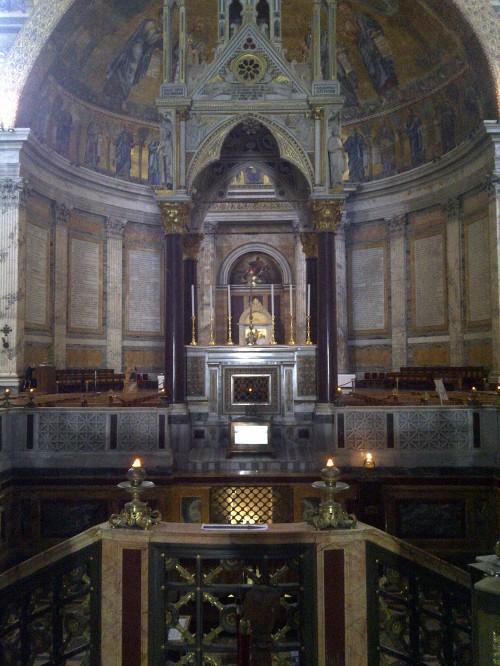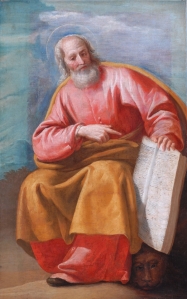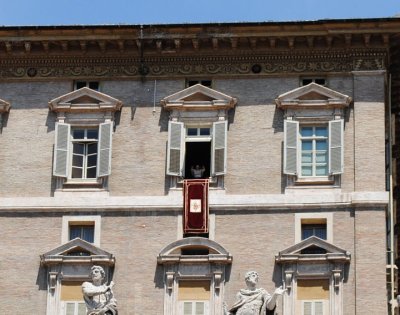On Thanksgiving Day, the priest directed the attention of the congregation to the painting of Our Lady of Guadalupe leaning against the flagstone wall near the sacristy. Father wanted to hang the painting up but first had to get permission from the Diocesan Office of Sacred Liturgy. So this raised the question about why the Church is taking great care to monitor the use of holy art.
Holy images in a church can enhance our awareness of the sacredness of the Mass and serve to inspire us with Christian models who dedicated their lives to Jesus.
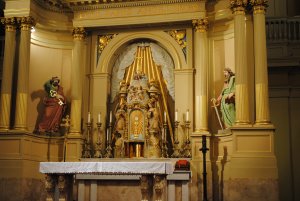
The Catholic Cathedral of St. Louis in New Orleans depicts Sts. Peter and Paul, both facing the tabernacle with a Latin inscription above saying, “Behold, the Bread of Angels”
When God gave Moses the Ten Commandments, He directed us to worship Him alone, “Thou shalt not have strange gods before me. Thou shalt not make to thyself a graven thing, nor the likeness of any thing that is in heaven above, or in the earth beneath it, nor of those things that are in the waters under the earth. Thou shall not adore them, nor serve them” -Exodus 20:3-5
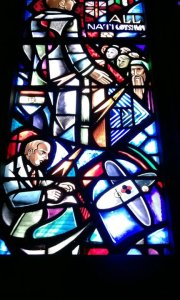
The National Cathedral(Anglican) in Washington has several stained glass windows depicting the life of General Robert E. Lee, the peaceful use of nuclear technology, and a depiction of the moon containing an actual reliquary with moon rocks.
The very first Christians did not view the use of holy images as a violation of this commandment. The Catacombs of St. Callixtus in Rome which depict cave like paintings of Christ as a lamb and the celebration of the Eucharist are examples of this. In fact, some 3rd century Jewish catacombs have been known to feature similar paintings but without the Christian overtones(Which is not evidence of justification, but merely an interesting note).
Martin Luther the Protestant Reformer even said, “The custom of holding a crucifix before a dying person has kept many in the Christian faith and has enabled them to die with a confident faith in the crucified Christ.”
God is omnipresent and so we are always in His presence, but churches offer a particular place of dedicated prayer and worship. The purpose of having sacred images and statues in Church is NOT for worship. These images are meant to enhance our awareness of God’s presence and of the many paths there are to reach his Son. As such, they should never be so numerous that they distract from the liturgy. The Cathedral of St. Louis shown above demonstrates a setting with a moderate number of statues, and note that they are all oriented slightly toward the tabernacle.
This critique is only for the purposes of respectfully examining how art can be used incorrectly. The National Cathedral(Anglican) in Washington DC is modeled after the Notre Dame Cathedral in Paris; however, the images and statues are half centered on God and half on man, which is a clear deviation from the intended purpose of the building. For example, the statue of Martin Luther(reformer) facing Desiderius Erasmus(reformer who defended primacy of the pope) can insight divisive feelings of “us vs. them” rather than directing attention to any Christian virtue the men may have exhibited.
There is also a large stained glass window commemorating the landing on the moon with a reliquary containing moon rocks which is not being used in any way to promote prayerful adoration, contrition, thanksgiving, or supplication.
The bottom line is that sacred art can be used to enhance our awareness of Christian virtue and place us in a mindset to pray a better prayer, but sacred images and statues must be carefully placed so that they do not distract from the greater honor and glory of God in the blessed sacrament.
A.M.D.G.




